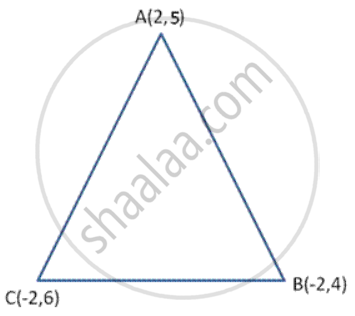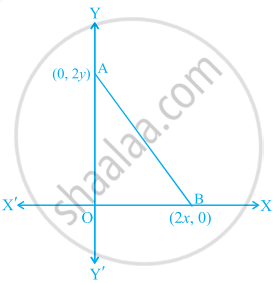Advertisements
Advertisements
प्रश्न
A(2, 5), B(-2, 4) and C(-2, 6) are the vertices of a triangle ABC. Prove that ABC is an isosceles triangle.
उत्तर

AB = `sqrt ((2 + 2)^2 + (5 - 4)^2) = sqrt (16 + 1) = sqrt 17` units
BC = `sqrt ((-2 + 2)^2 + (4 - 6)^2) = sqrt (0 + 4)` = 2 units
AC = `sqrt ((2 + 2)^2 + (5 - 6)^2) = sqrt (16 + 1) = sqrt 17` units
It can be seen that AB = AC
Hence , the given coordinates are the vertices of an isosceles triangle.
APPEARS IN
संबंधित प्रश्न
If A(4, 3), B(-1, y) and C(3, 4) are the vertices of a right triangle ABC, right-angled at A, then find the value of y.
If P (2, – 1), Q(3, 4), R(–2, 3) and S(–3, –2) be four points in a plane, show that PQRS is a rhombus but not a square. Find the area of the rhombus
Find the circumcenter of the triangle whose vertices are (-2, -3), (-1, 0), (7, -6).
Find all possible values of x for which the distance between the points
A(x,-1) and B(5,3) is 5 units.
`" Find the distance between the points" A ((-8)/5,2) and B (2/5,2)`
Find the distance between the following pairs of point.
W `((- 7)/2 , 4)`, X (11, 4)
Prove that the points (1 ,1),(-4 , 4) and (4 , 6) are the certices of an isosceles triangle.
Find the co-ordinates of points on the x-axis which are at a distance of 17 units from the point (11, -8).
The coordinates of the point which is equidistant from the three vertices of the ΔAOB as shown in the figure is ______.

Ayush starts walking from his house to office. Instead of going to the office directly, he goes to a bank first, from there to his daughter’s school and then reaches the office. What is the extra distance travelled by Ayush in reaching his office? (Assume that all distances covered are in straight lines). If the house is situated at (2, 4), bank at (5, 8), school at (13, 14) and office at (13, 26) and coordinates are in km.
